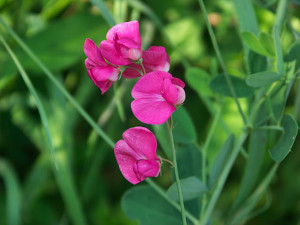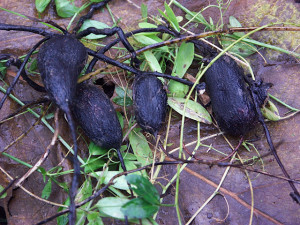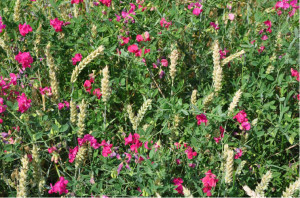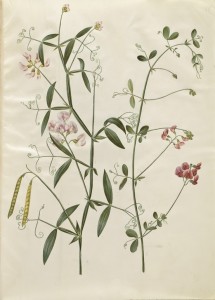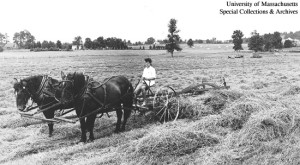
How I mowed hay in my youth. Photo Powerhouse Museum
Anyone who has mowed fields for hay hates vetch… wild pea. It binds up the machinery and a lot of livestock won’t eat it. That’s a lose lose all around unless the vetch is Lathyrus tuberosus.
A decade of my life was spent haying with just such a mower above. I know every part of it intimately, personally, mechanically, greasily, irritatingly… Whether pulled by horses or a tractor the larger wheels turned a lateral shaft which changed the circular motion via a wooden “pitman” to a horizontal movement, a six-foot blade of piranha teeth swishing back and fourth through the sicklebar. Whenever you hit a patch of vetch the resistance of the stems was more than the mechanical power to cut through them. That’s when one of two things would happen. The ash pitman (the stick in the lower middle, above and right of the small wheel) would splinter, or if the pitman was made of sterner stuff, the small wheel would trigger a spring release and the entire left side of the mower in front of the big back wheel would break free and swing back like a broken arm. This required stopping, cleaning the vetch from the sicklebar bar, then backing the entire contraption until the sicklebar bar snapped back into place. If the pitman broke it was the end of haying for that day, the evening spent in repairs. The bane of mowing hay was either vetch, or, ground hornets who were not happy when you cut off the top of their home.
Vetch…. legumes — peas and beans if you will permit the common grouping — land all over the foraging spectrum from edible to toxic to this part edible and that part not. Thus it is with the Lathyrus tuberosus (LAY-thigh-russ two-burr-OH-sus.) The seeds are toxic in quantity, the crisp cooked roots are delicious on par with sweet chestnuts. Raw they have more of a pea flavor. It makes one wonder how a plant once esteemed for its tasty tuber is now a noxious weed in many places… maybe haying had something to do with it. Another issue with this “invasive” is what do we call it? Tuber Vetchling, Earthnut Pea, Aardaker, Tuberous Sweetpea, Tanotte, Gland-de-terre, Gesse tubéreuse, châtaigne de terre, Fyfield Pea, Pebble Pea, Heath Pea, Pea Earth Nut, Earth Chestnuts, Dutch Mice, Earth Mouse. I like Dutch Mice and there are several Earthnuts/Chestnuts out there but let’s go with Tuberous Sweetpea. That is reasonably descriptive and accurate.
The Tuberous Sweetpea is native to Eurasia but is also found across much of northern North America. Cultivated since the 1600’s many consider it an “antique vegetable” once popular but now passe. That’s not really accurate. In taste tests the Tuberous Sweetpea always rates high and numerous plans have been made to make it a commercial crop. The problem is the plant does not agree to be domesticated. A consistent crop is difficult to maintain so it has not become a commercial staple. That’s doesn’t mean me and thee can’t harvest a lot of it and enjoy it, or even raise it. The roots can be boiled or roasted. Some also eat the root raw though it might be mildly toxic that way. There is also “lathyrism” to consider.
Some members of this large genus — Lathyrus sativus for example — have a toxic amino acid in the seeds that can cause a nerve disease if eaten in large amounts. While some caution is advised that “large amount” is when the seeds are 30 to 50 percent of ones diet. Not exactly a problem for most. Also edible are the seeds and young pods of the Lathyrus japonicus ssp. matitimus, with the same caution. However note only the root of the Lathyrus tuberosus is eaten, preferably cooked. It’s also used to favor some scotch whiskey. The root of the Lathyrus linifolius, “knappers” are also eaten. I have not been able to substantiate that the roots of the Lathyrus amphicarpus are edible.
To reiterate the seeds of Lathyrus species — there are 187 of them — are toxic particularly when consumed often and in large quantities. The tubers of the Lathyrus tuberosus were a common food in Europe often sold in produce markets particularly in France under the name “macusson.” Botanically Lathyrus is from the Greek Lathyros which is an old name for pea. Tuberosus is Dead Latin meaning tuberous, referring to the thickened roots.
Green Deane’s Itenized” Plant Profile: Tuberous Sweetpea
INDENTIFICATION: Lathyrus tuberosus: Perennial herb with nut-sized tubers, 12 to 32 inches high, stem limp, sometimes climbing, bristly, wingless, hairless. Flower irregular, rose red if not crimson, five petals standard pea blossom, lateral two petals the ‘wings’, the lower two petals united to form the ‘keel’, overall shape of corolla being butterfly-like. Stamens 10, strong fragrance. Leaves alternate, stalked, elliptic–lanceolate, blunt, no teeth, bluish green. Fruit long, flat, brown pod with three to six seeds. Tubers can be up to 16 inches deep. Oh, by the way you will read that the plant’s stipules (dwarfed petals) are semisagittate. Who on earth thought that term up? It means half an arrow tip…
TIME OF YEAR: Flowering June to September, depending on climate, seeds in the fall. Left on it own the plant develops root rather deep. To avoid that problem under cultivation it is best to plant them in containers. Harvest in late fall or early spring.
ENVIRONMENT: Likes limestone rich soil, forests, hedgerow, roadsides, railway yards, wasteland, parks, sometimes ornamental. Nitrogen fixer. Easily trellised.
METHOD OF PREPARATION: Roots boiled or roasted. Roots boiled for about 10 minutes. Some people like to steam the flowers and eat them. You are on your own with that. To cultivate the Tuberous Sweet Pea either plants the roots or used the seeds. Soak the seeds overnight then plant in spring, preferably in a container. The Providence of Ontario classifies it as a noxious weed.
To read about the amino acids in the genus go here.

